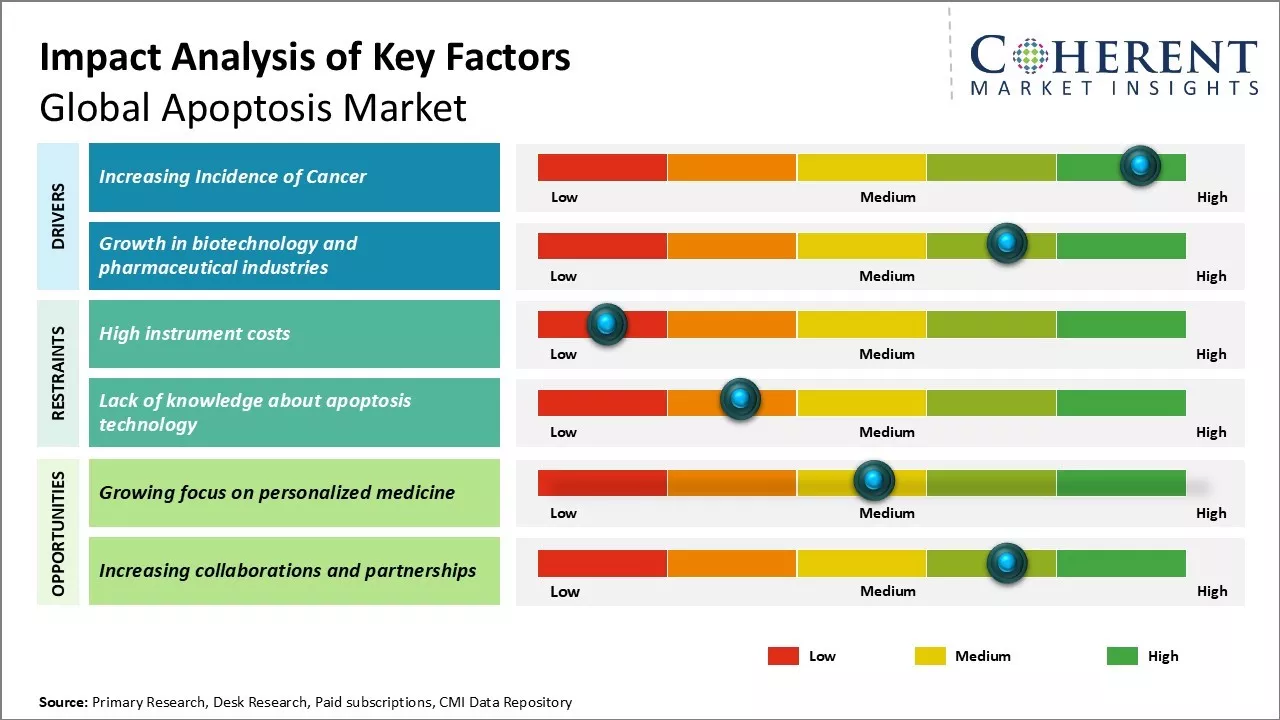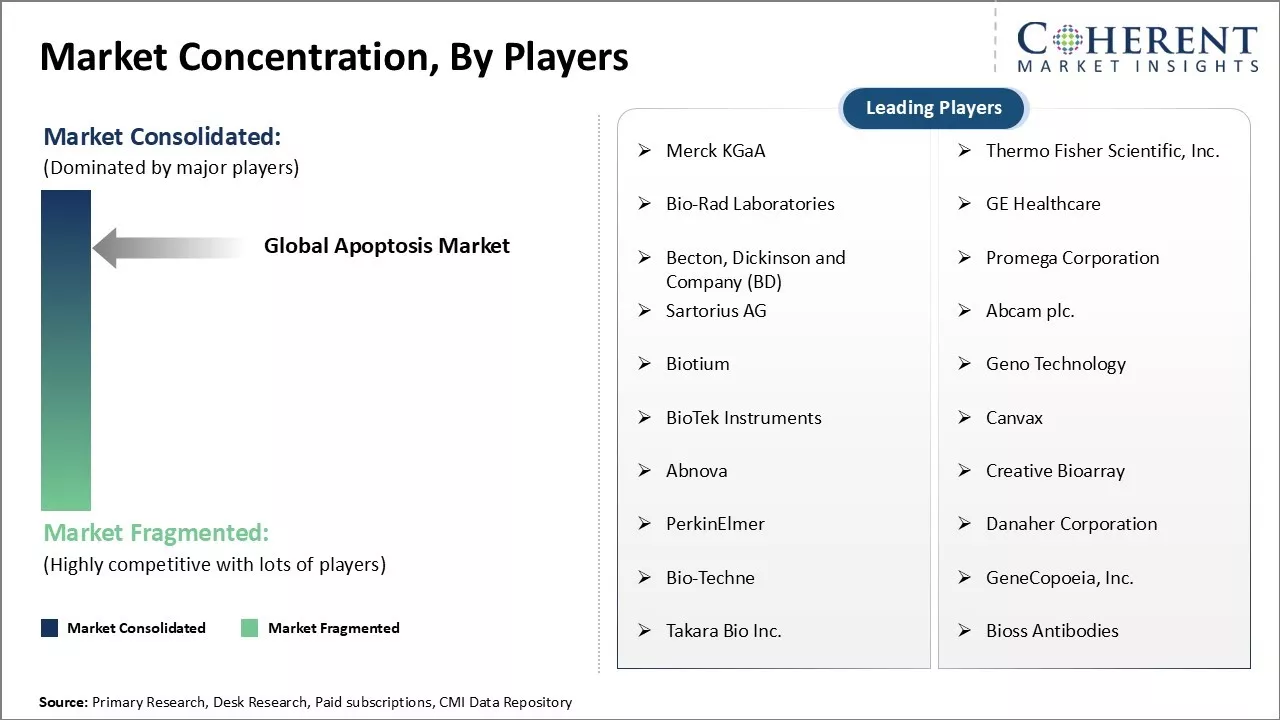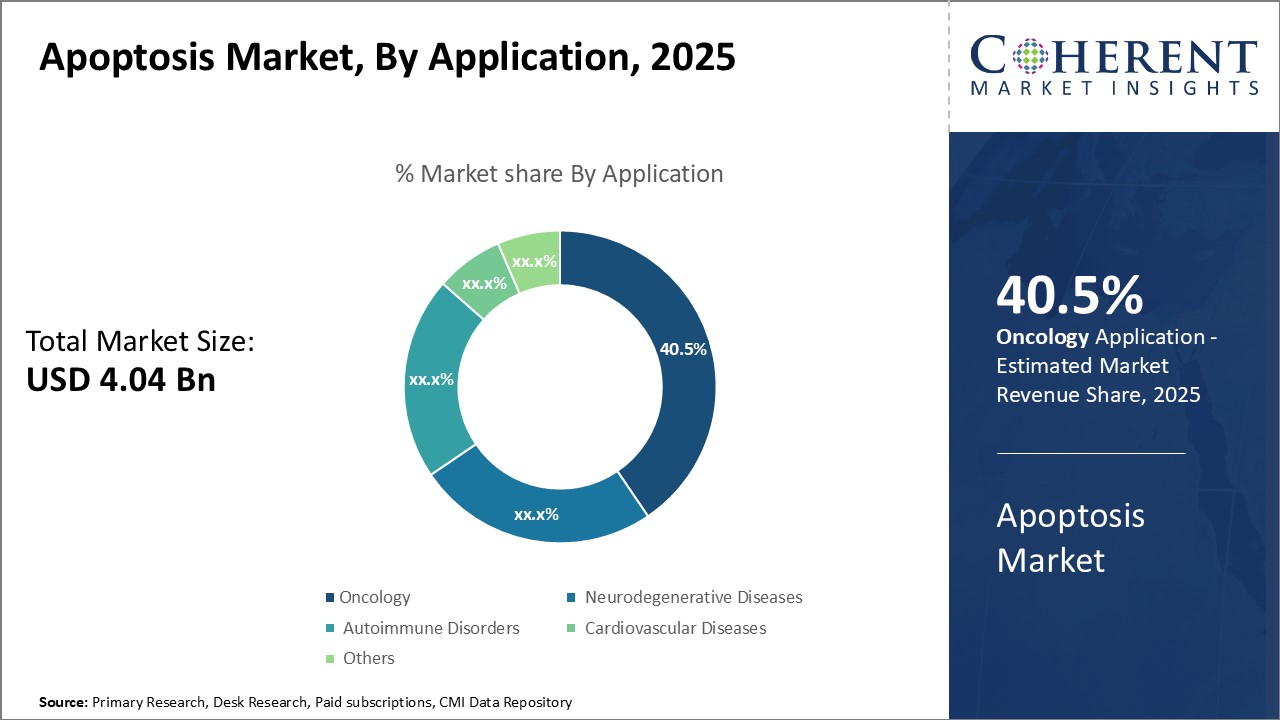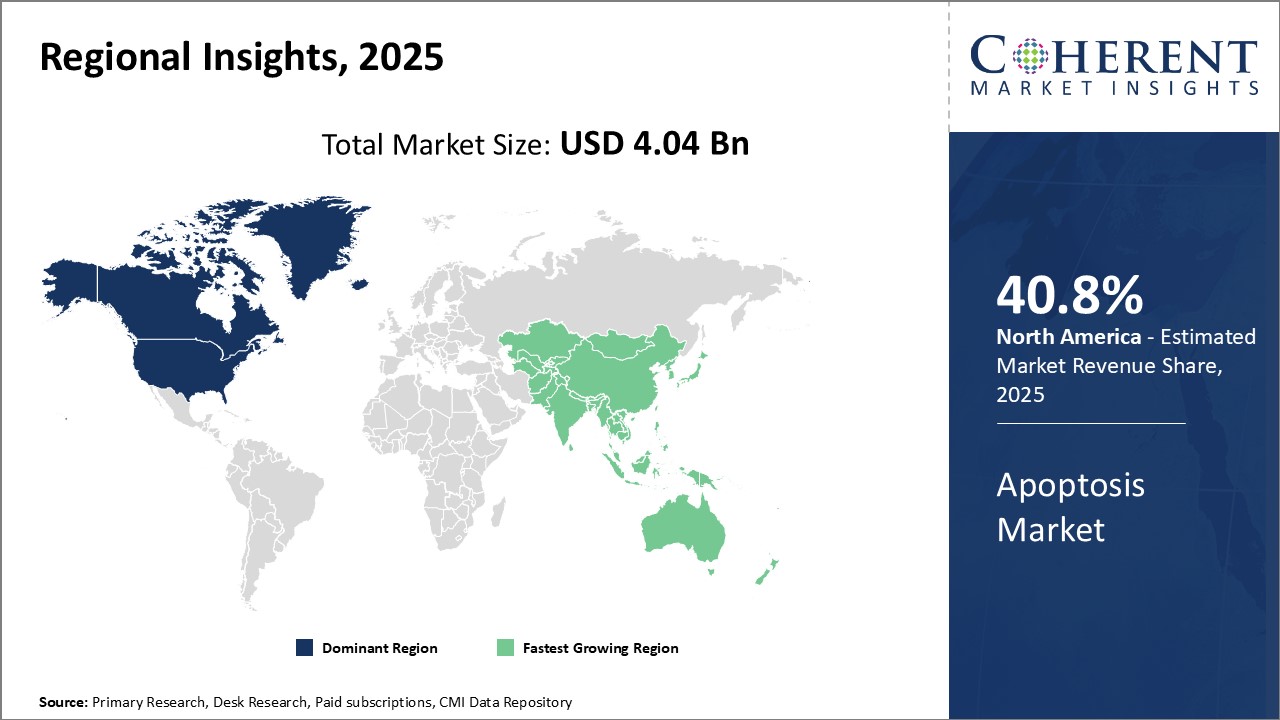Apoptosis Market Size and Trends
The Global Apoptosis Market is estimated to be valued at USD 4.04 Billion in 2025 and is expected to reach USD 6.08 Billion by 2032, exhibiting a compound annual growth rate (CAGR) of 6.0% from 2025 to 2032.

Discover market dynamics shaping the industry: Download Free Sample
The apoptosis market is witnessing significant growth due to rising incidences of cancer and increasing research & development activities in pharmaceutical and biotechnology companies. Growing aging population susceptibility to chronic diseases and rising healthcare expenditure are also driving the demand for apoptosis-regulating drugs. Furthermore, increasing approvals and launch of novel drugs are providing opportunities for market growth. However, high cost associated with apoptosis drug development and strict regulatory guidelines for drug approval are expected to hinder the market growth.
Market Driver - Increasing Incidence of Cancer
One of the primary drivers for the growth of the global apoptosis market is the rising incidence of various types of cancer cases across the globe. Cancer has become one of the leading causes of mortality worldwide, and according to the World Health Organization, the global cancer burden is expected to rise significantly in the coming decades mainly due to aging and growth of the world population along with an increasing adoption of cancer-causing behaviors. It is estimated that the global cancer cases will surge by over 70% in the next couple of decades and oncology medicines will continue playing a crucial role in helping physicians manage and treat this rising disease. Apoptosis or programmed cell death is an integral process in the human body for eliminating old or abnormal cells and regulating normal cell replacement. However, certain mutations in genes can disrupt apoptosis pathways leading to uncontrolled cell proliferation and growth of cancerous tumors. Researchers have demonstrated significant differences in apoptotic pathways between normal and tumor tissues and this has opened doors for novel drug development targeting specific anti-apoptotic genes and proteins for improved therapy outcomes. Many targeted therapies and immunotherapies in oncology today function by enhancing or restoring intrinsic apoptosis mechanisms in cancer cells. The growing cancer burden is thus encouraging increased spending on apoptosis-based drugs and R&D by sponsors to develop more advanced treatment options against various deadly cancers. This rising incidence of different types of cancers worldwide is functioning as a key driver for the expansion of the global apoptosis market. On February 2025, For instance, According to WHO Ahead of World Cancer Day, the WHO's International Agency for Research on Cancer (IARC) reported an estimated 20 million new cancer cases and 9.7 million deaths in 2022, with 53.5 million people living within five years of a cancer diagnosis. A WHO survey across 115 countries revealed that only 39% adequately finance basic cancer management, and just 28% include palliative care in their universal health coverage packages, highlighting significant global disparities in cancer care.
Market Concentration and Competitive Landscape

Get actionable strategies to beat competition: Download Free Sample
Growth in biotechnology and pharmaceutical industries
Another major factor expected to propel the global apoptosis market in the coming times is the exceptional growth being witnessed in the biotechnology and pharmaceutical sectors. After a sustained rise over the last few decades, these industries have truly transformed into multi-billion-dollar powerhouses with massive potential for disruptive innovation. In particular, areas of specialty such as immunology, oncology, and genetic/cell therapies have attracted sizable investments from industry stakeholders, and this is fueling intensive research activities in academia and industry. The research areas of gene regulation, cell signaling pathways, and new drug targets are helping develop deeper scientific understanding of the fascinatingly complex apoptosis process at the molecular level. Advanced technologies such as next-generation sequencing, stem cell engineering, bioinformatics, and genetic manipulation methods are enabling scientists to better study apoptosis dysregulation in disease conditions and swiftly translate findings into potential drug candidates. Meanwhile, there is noticeable merger and acquisition activity as well as partnership deals emerging between large pharmaceutical firms, biotech, and research institutes aimed at accelerating drug development pipelines. Given the pivotal role of apoptosis mechanisms in various severe and life-threatening disorders, the biotech and pharmaceutical sectors' aggressive research thrust on this subject is expected to bear many innovative treatment solutions for apoptosis-related diseases over the coming years, significantly propelling the overall industry.
Key Takeaways from Analyst:
The global apoptosis market is poised to witness steady growth in the coming years due to rising cases of cancer and various chronic diseases worldwide. The increasing R&D expenditure for novel drug discovery and the growing acceptance of targeted therapy are some of the major drivers contributing to the growth of this market. However, the availability of alternatives for apoptosis modulation and ethical concerns related to apoptotic research can hamper the market progress.
North America dominates the current market landscape owing to the strong presence of global players and availability of advanced healthcare facilities. On the other hand, Asia Pacific is expected to showcase the fastest growth rate during the forecast period. This can be attributed to factors such as rising healthcare spending, an increasing patient population, and growing awareness regarding apoptosis-based technologies.
From a technological standpoint, the advent of stem cell-based therapies along with biomarkers for apoptosis assessment is expected to open new avenues of growth for market players. Furthermore, the increasing focus on drug repositioning by pharma companies can provide profitable opportunities. Companies should invest in R&D to discover drugs targeting novel apoptosis pathways. Collaborations with research institutes can also help gain insights into disease-specific apoptotic mechanisms.
Market Challenge - High instrument costs
One of the major challenges faced by the global apoptosis market is the high costs associated with instruments and equipment used for apoptosis detection and analysis. Apoptosis research requires the use of sophisticated and expensive instruments such as flow cytometers, fluorescence microscopes, and high-content screening systems. These instruments can cost anywhere between US$ 100,000 and over US$ 1 million depending on their application and features. Additionally, costs associated with regular maintenance and software upgrades of such instruments adds further financial burden on research organizations and pharma companies. The high capital expenditure restricts widespread proliferation of apoptosis research, especially in cash-strapped academic research institutions and small biotech companies. To address this, market players need to focus on the development of more affordable bench-top and portable apoptosis detection instruments without compromising much on performance, sensitivity, and throughput. This can help in improving accessibility and facilitate further penetration of apoptosis tools into newer end-use segments.
Market Opportunity- Growing focus on personalized medicine
The growing focus on personalized medicine across the globe presents a major opportunity for the apoptosis market. Personalized medicine aims to tailor treatment and therapy based on a patient's genetic profile and molecular characteristics. Apoptosis plays a crucial role in individual response to drugs, development of resistance to therapy, and diseases progression. As such, deep understanding of a patient's apoptotic pathway is key to developing targeted and customized treatment regimens. The demand for apoptosis detection tools and assays is expected to substantially increase from pharmaceutical and biotech companies engaged in the development of personalized medicines. Additionally, contract research organizations and clinical labs supporting drug development would focus on the procurement of advanced apoptosis analysis systems. Overall, the shift towards precision medicine could significantly boost the revenues of apoptosis market players in the coming years.

Discover high revenue pocket segments and roadmap to it: Download Free Sample
By Application - Growing Cancer Prevalence Drives Oncology Segment Growth
In terms of application, the oncology segment is estimated to dominate the highest share of the market with 40.5% in 2025 owing to the rapidly growing prevalence of various types of cancer globally. Cancer is one of the leading causes of mortality worldwide, with an estimated 9.6 million cancer deaths and 18.1 million new cancer cases in 2018. The rising incidences of breast cancer, lung cancer, colorectal cancer, and prostate cancer are major factors propelling the demand for apoptosis-related technologies and services in the oncology segment. Apoptosis plays an important role in the sensitivity of cancer cells to various therapies such as chemotherapy, targeted therapy and immunotherapy. An improved understanding of apoptosis signaling pathways in tumor cells has enabled oncologists to develop targeted therapies that induce apoptosis in cancer cells. This in turn is fueling the uptake of apoptosis assays, antibodies and inhibitors/inducers tailored for various cancer applications.
By Modality - Growing Focus on Neurodegenerative Disease Research Augments Assays Segment
In terms of modality, the apoptosis assays segment is estimated to dominate the highest share of the market 52.8% in 2025 owing to their widespread applications in research and clinical testing. Apoptosis assays enable precise detection and quantification of apoptotic cell death, which is critical for research into neurodegenerative diseases. Neurological disorders such as Alzheimer's disease, Parkinson's disease, Huntington's disease, and multiple sclerosis involve neuronal loss due to apoptosis. Growing research efforts into elucidating the apoptotic mechanisms underlying these conditions are driving the demand for various types of apoptosis assays. Additionally, apoptosis assays assume significance in drug discovery and development efforts targeting neurodegenerative diseases. They help evaluate the pro-apoptotic or anti-apoptotic activities of novel drug candidates. Such extensive research and development applications of apoptosis assays account for their large market share in the global apoptosis market.
By End User - Increase in R&D Outsourcing Boosts Pharmaceutical Companies Segment
In terms of end user, the pharmaceutical and biotechnology companies segment is estimated to contribute the highest share with 42.8% in 2025 due to their vast R&D investments and clinical trials pipelines. The development and commercialization of new apoptosis-targeting drugs entail significant investments and specialized expertise, forcing many pharmaceutical players to partially outsource their R&D activities. This has augmented the market share of contract research organizations who provide apoptosis testing and research services to drug developers. Additionally, academic and research institutes globally are actively engaged in apoptotic mechanisms research with the support of funding from pharmaceutical players. Such collaborative relationships between pharmaceutical companies, CROs, and research institutes have made them the major end users driving the global apoptosis market growth.
Regional Insights

Need a Different Region or Segment? Download Free Sample
North America has dominated the global apoptosis market with an estimated share of 40.8% in 2025 for many years due to strong presence of leading biotechnology and pharmaceutical companies in the region. The U.S. alone accounts for over 40.5% of the global market share owing to availability of state-of-the-art healthcare infrastructure and rapid adoption of advanced diagnostic technologies. Major players such as Thermo Fisher Scientific, Merck, Abcam, and BD Biosciences have their headquarters in the region and introduce new apoptosis detection kits and assays regularly, catering to the diverse needs of end users. Furthermore, considerable funding from both private and government sectors have promoted research activities in cell death and cancer study, thereby contributing to the large market size.
Asia Pacific has emerged as the fastest growing regional market in recent times on account of increasing healthcare expenditures and expansion of cancer research facilities. China and India are expected to lead the growth owing to raising awareness about chronic diseases and improving accessibility to advanced medical services. Foreign players are also targeting these developing nations to tap huge patient population and benefit from low manufacturing costs. This has positively impacted the imports/exports scenario and price points are quite competitive when compared to developed markets. The apoptosis market is still in a growing phase due to ongoing development of laboratory infrastructure and recruitment of skilled medical professionals.
Overall, growing global geriatric population susceptible to cancer, neurodegenerative disorders, and cardiac ailments will sustain the demand for apoptosis monitoring over the next decade. While North America dominates with its strong innovation capability and clinical research strengths presently, Asia's economies offer immense scope for future market expansion led by unmet needs, healthcare reforms, and conducive government policies. Players need to devise prudent strategies around geographic expansion, novel product launches and strategic partnerships for sustainable leadership in this high growth industry.
Market Report Scope
Apoptosis Market Report Coverage
| Report Coverage | Details | ||
|---|---|---|---|
| Base Year: | 2024 | Market Size in 2025: | USD 4.04 Bn |
| Historical Data for: | 2020 To 2024 | Forecast Period: | 2025 To 2032 |
| Forecast Period 2025 to 2032 CAGR: | 6.0% | 2032 Value Projection: | USD 6.08 Bn |
| Geographies covered: |
|
||
| Segments covered: |
|
||
| Companies covered: |
Merck KGaA, Thermo Fisher Scientific, Inc., Bio-Rad Laboratories, GE Healthcare, Becton, Dickinson and Company (BD), Promega Corporation, Sartorius AG, Abcam plc., Biotium, Geno Technology, BioTek Instruments, Canvax, Abnova, Creative Bioarray, PerkinElmer, Danaher Corporation, Bio-Techne, GeneCopoeia, Inc., Takara Bio Inc., and Bioss Antibodies |
||
| Growth Drivers: |
|
||
| Restraints & Challenges: |
|
||
Uncover macros and micros vetted on 75+ parameters: Get instant access to report
Apoptosis Industry News
- In December 2022, TransGen has launched a series of Annexin V detection kits for early apoptosis detection. These kits are highly sensitive, specific, and easy to use, suitable for flow cytometry and fluorescence microscopy. The TransDetect Annexin V-FITC/PI Cell Apoptosis Detection Kit is highlighted for its ability to differentiate between live, apoptotic, and necrotic cells using FITC and Propidium Iodide (PI) staining.
- In September 2022, Merck announced that its Inhibitor of Apoptosis Protein (IAP), xevinapant (formerly known as Debio 1143), combined with chemoradiotherapy (CRT), had significantly enhanced long-term efficacy outcomes for patients with unresected locally advanced squamous cell carcinoma of the head and neck (LA SCCHN) compared to placebo combined with CRT.
*Definition: The global apoptosis market provides products and services related to apoptosis research, drug development and clinical applications. This market caters to biotechnology and pharmaceutical companies, research laboratories and academic institutions engaged in developing apoptosis modulating drugs for cancer, autoimmune disorders, neurodegenerative diseases and other therapeutic areas. Products included in this market are reagents, assays, instruments and analytical tools used in apoptosis research and screening for new drug candidates.
Market Segmentation
- By Application Insights (Revenue, USD Bn, 2020 - 2032)
-
- Oncology
- Neurodegenerative Diseases
- Autoimmune Disorders
- Cardiovascular Diseases
- Others
- By Modality Insights (Revenue, USD Bn, 2020 - 2032)
-
- Apoptosis Assays
- Apoptosis Antibodies
- Apoptosis Inhibitors and Inducers
- By End User Insights (Revenue, USD Bn, 2020 - 2032)
-
- Pharmaceutical and Biotechnology Companies
- Academic and Research Institutes
- Contract Research Organizations
- Ohers
- Regional Insights (Revenue, USD Bn 2020 - 2032)
- North America
- U.S.
- Canada
- Latin America
- Brazil
- Argentina
- Mexico
- Rest of Latin America
- Europe
- Germany
- U.K.
- Spain
- France
- Italy
- Russia
- Rest of Europe
- Asia Pacific
- China
- India
- Japan
- Australia
- South Korea
- ASEAN
- Rest of Asia Pacific
- Middle East
- GCC Countries
- Israel
- Rest of Middle East
- Africa
- South Africa
- North Africa
- Central Africa
- North America
- Key Players Insights
-
- Merck KGaA
- Thermo Fisher Scientific, Inc.
- Bio-Rad Laboratories
- GE Healthcare
- Becton, Dickinson and Company (BD)
- Promega Corporation
- Sartorius AG
- Abcam plc.
- Biotium
- Geno Technology
- BioTek Instruments
- Canvax
- Abnova
- Creative Bioarray
- PerkinElmer
- Danaher Corporation
- Bio-Techne
- GeneCopoeia, Inc.
- Takara Bio Inc.
- Bioss Antibodies
Share
Share
About Author
Ghanshyam Shrivastava - With over 20 years of experience in the management consulting and research, Ghanshyam Shrivastava serves as a Principal Consultant, bringing extensive expertise in biologics and biosimilars. His primary expertise lies in areas such as market entry and expansion strategy, competitive intelligence, and strategic transformation across diversified portfolio of various drugs used for different therapeutic category and APIs. He excels at identifying key challenges faced by clients and providing robust solutions to enhance their strategic decision-making capabilities. His comprehensive understanding of the market ensures valuable contributions to research reports and business decisions.
Ghanshyam is a sought-after speaker at industry conferences and contributes to various publications on pharma industry.
Missing comfort of reading report in your local language? Find your preferred language :
Transform your Strategy with Exclusive Trending Reports :
Frequently Asked Questions
EXISTING CLIENTELE
Joining thousands of companies around the world committed to making the Excellent Business Solutions.
View All Our Clients
